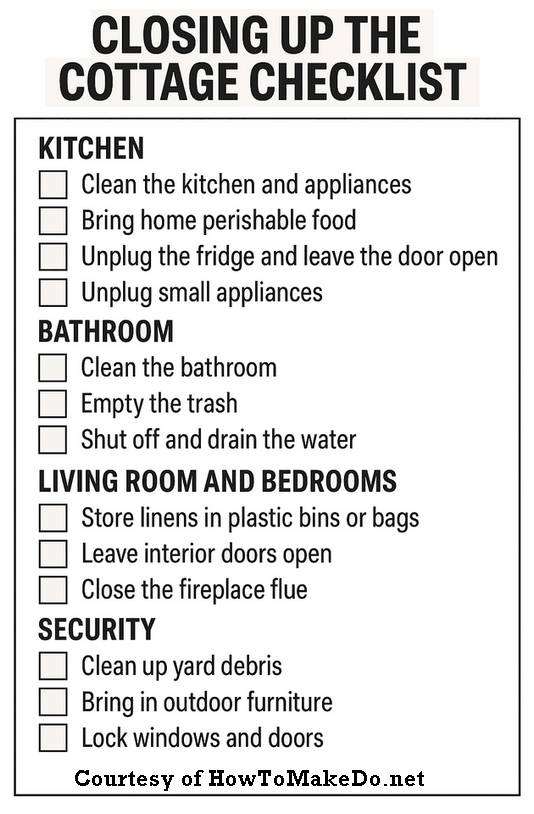Last updated on April 21st, 2025 at 09:43 pm

Closing the Cottage for the Season: A Smart End-of-Summer Checklist
As the crisp autumn air rolls in and the trees begin changing colours, it’s time to close up the cottage for the off-season. While it may feel like a chore, taking careful steps now can help protect your property from winter damage, wildlife intrusions, and unexpected surprises come spring.
Follow this handy checklist to make your seasonal shutdown smooth and stress-free. A free printable summarized checklist is available at the bottom of this post:
Inside the Cottage
Kitchen
- Clean thoroughly. Wipe down all surfaces, including inside cupboards, and clean out appliances to prevent mold, mildew, and critter infestations.
- Remove all food. Even canned goods can freeze and explode. Take home all perishables and dry goods.
- Unplug and defrost the fridge and freezer. Prop the doors open to keep air flowing and prevent musty smells.
- Unplug small appliances (toasters, coffee makers, etc.) and leave microwave doors ajar to air out.
Related Posts: Natural Spring Cleaning, How to Organize a Garage Sale, How to Organize a Linen Closet.
Bathroom
- Scrub and sanitize sinks, toilets, tubs, and showers.
- Drain and dry all plumbing if you’re turning off the water supply (see tips below).
- Take out the trash and any recycling to prevent odors and pests.
Living Spaces & Bedrooms
- Pack away linens in sealed plastic containers or vacuum bags to keep out moisture and rodents.
- Open interior doors and cupboards for air circulation.
- Close the fireplace flue and consider sealing it with a chimney balloon or cap to prevent drafts and critters.
Plumbing & Utilities
- Shut off the main water supply and drain pipes by opening taps and flushing toilets. Use an air compressor if needed to clear lines completely.
- Add RV antifreeze to toilet bowls, tanks, sink traps, and drains if you’re in a deep-freeze area.
- Turn down or turn off the heat, depending on whether you’re maintaining minimal heat or going full shutdown.
- Unplug electronics and switch off breakers to non-essential circuits to save energy and reduce fire risk.
Outside the Cottage
- Store outdoor furniture and cushions indoors or cover with waterproof tarps.
- Clean and store your BBQ (and remove propane tanks to a safe, ventilated area).
- Drain and secure small boats, canoes, or kayaks. Remove motors and electronics and store them in a dry space.
- Secure all windows and doors. Use storm shutters or fitted plywood if the area is prone to break-ins or bad storms.
- Remove fire hazards such as old rags, chemicals, or kindling stored too close to the building.
- Check and clean gutters to prevent ice dams and water damage.
Security & Insurance
- Forward your mail or pause deliveries to avoid obvious signs that no one’s home.
- Install timers or smart lights for a lived-in look.
- Consider a security system or remote monitoring camera, especially if you’re in an isolated area.
- Let a trusted neighbor or caretaker know you’re away and ask them to check in occasionally.
- Review your insurance to ensure your cottage is covered for winter-related risks like burst pipes, storm damage, or vandalism.
✅ Bonus Cottage Closing Tips
- Document everything. Snap photos of the interior, exterior, and any valuables for insurance purposes.
- Leave a checklist for spring re-opening — it’ll make next year’s start easier.
- Double-check windows, locks, and all shut-offs before you leave.
Final Cottage Closing Step:
Print the following HowToMakeDo.net summarized check list and check off each chore as you get it done.

Closing your cottage properly ends the season with peace of mind. A little effort now means you’ll return next year to a place that’s safe, sound, and ready for another summer of memories at the cottage.
